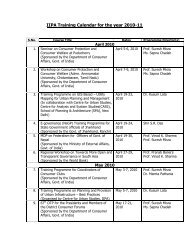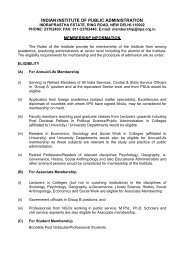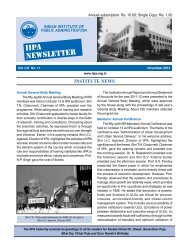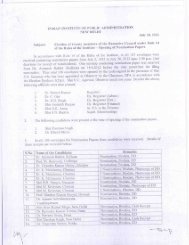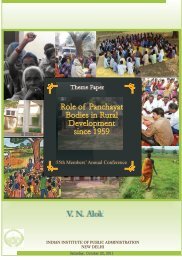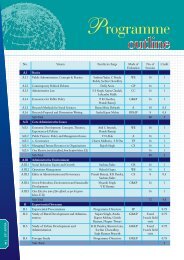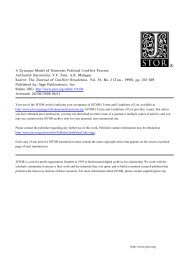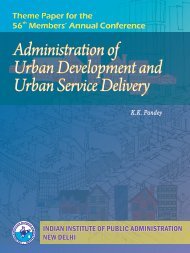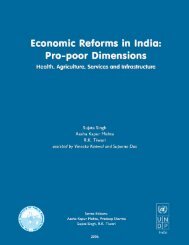Privatisation of Health Care in India - Indian Institute of Public ...
Privatisation of Health Care in India - Indian Institute of Public ...
Privatisation of Health Care in India - Indian Institute of Public ...
- No tags were found...
Create successful ePaper yourself
Turn your PDF publications into a flip-book with our unique Google optimized e-Paper software.
<strong>Privatisation</strong> <strong>of</strong> <strong>Health</strong> <strong>Care</strong> <strong>in</strong> <strong>India</strong>5.2. Utilisation <strong>of</strong> Inpatient ServicesWhen it comes to <strong>in</strong>patient services the picture is somewhatdifferent. An analysis <strong>of</strong> the 42 nd round <strong>of</strong> the NSSdata at the all <strong>India</strong> level reveals that only around 36 percent<strong>of</strong> the hospitalisations were <strong>in</strong> private hospitals <strong>in</strong> urbanareas and around 35 percent <strong>in</strong> rural areas. InMaharashtra, around 48 percent <strong>of</strong> the households hadused a private hospital <strong>in</strong> urban areas while <strong>in</strong> rural areasthe figure was around 54 percent. In Karnataka, around50 percent <strong>in</strong> urban areas and around 38 percent <strong>in</strong> ruralareas had used private sources for treatment. In Orissa,around 15 percent <strong>in</strong> urban and seven percent <strong>in</strong> rural areashad been treated <strong>in</strong> a private hospital (Tables 9 and 10).The 52 nd round <strong>of</strong> the NSS data shows that at the all <strong>India</strong>level 54.7 percent <strong>of</strong> households <strong>in</strong> rural areas and 56.9percent <strong>in</strong> urban areas had utilised private hospitals forhospitalisation. There has def<strong>in</strong>itely been an <strong>in</strong>crease <strong>in</strong> theproportion <strong>of</strong> persons utilis<strong>in</strong>g the private sector betweenthe 42 nd and 52 nd rounds <strong>of</strong> the NSS, which is roughlyover a decade.In Maharashtra, 68.8 percent <strong>in</strong> rural areas and 68.2 <strong>in</strong> urbanareas had utilised private sources. In Karnataka, 54.2percent <strong>in</strong> rural areas and 70.2 <strong>in</strong> urban areas had utilisedprivate sources. In Orissa, 9.4 percent <strong>in</strong> rural areas and 19percent <strong>in</strong> urban areas had utilised private sources. Apartfrom the <strong>in</strong>ter-state differences <strong>in</strong> the utilisation <strong>of</strong> the privatesector there is also a difference between the poorestand richest qu<strong>in</strong>tiles. An analysis <strong>of</strong> the 52 nd round <strong>of</strong> theNSS shows an <strong>in</strong>terest<strong>in</strong>g picture that at the all <strong>India</strong> level39 percent <strong>of</strong> the poorest qu<strong>in</strong>tile were us<strong>in</strong>g the privatesector for hospitalisation while 77 percent <strong>of</strong> the richestqu<strong>in</strong>tile were utilis<strong>in</strong>g the private sector. Among the threestates, the poorest <strong>in</strong> Orissa relied more on the public sectorthan either Karnataka or Maharashtra. In many states,the middle and lower middle <strong>in</strong>come groups have startedus<strong>in</strong>g the private sector while the poor still cont<strong>in</strong>ue to relyon public hospitals. Therefore, there is a clear <strong>in</strong>dicationthat the utilisation <strong>of</strong> the private sector <strong>in</strong>creases as the<strong>in</strong>come gradient <strong>in</strong>creases. As far as the vulnerable sectionsviz. SCs and STs are concerned, utilisation by STs is verylow <strong>in</strong> both the public and private sectors while <strong>in</strong> the case<strong>of</strong> SCs it is marg<strong>in</strong>ally higher and the dependence is greateron the public than the private sector.The NCAER survey on the utilisation <strong>of</strong> <strong>in</strong>patient careshows that 38 percent <strong>of</strong> people <strong>in</strong> rural areas and 40 percent<strong>in</strong> urban areas opt for private sources at the all <strong>India</strong>level. In Maharashtra, 69.5 percent <strong>of</strong> people <strong>in</strong> rural areasand 41.2 percent <strong>in</strong> urban areas opted for private sources.In Karnataka, 38.9 percent and 42.2 percent opted for privatesources <strong>in</strong> rural and urban areas respectively. In Orissa,a mere 1.9 percent <strong>of</strong> people <strong>in</strong> rural areas and 31.3 <strong>in</strong>urban areas opted for private sources (Sunder, 1992).While there is some variation between the f<strong>in</strong>d<strong>in</strong>gs <strong>of</strong> NSSand NCAER surveys across the three states, it also broadlyreflects the structures <strong>of</strong> provision<strong>in</strong>g <strong>in</strong> terms <strong>of</strong> privateand public sectors <strong>in</strong> these three states. Maharashtra has ahigher proportion <strong>of</strong> private beds, followed by Karnatakaand lastly Orissa, which is clearly reflected <strong>in</strong> the utilisationpatterns as well. The important issue to be underscored isthat <strong>in</strong> all three states there is dependence on the publicsector, especially for <strong>in</strong>patient care, but the degree <strong>of</strong> dependencevaries across these states.The NFHS also provides data on the proportion <strong>of</strong> deliveriestak<strong>in</strong>g place <strong>in</strong> <strong>in</strong>stitutions. Invariably, they are quitelow among the vulnerable sections. At the all <strong>India</strong> level,10.9 percent <strong>of</strong> the SCs used public hospitals while a mere5.1 percent used a private hospital. Among the STs, 6.7percent used public hospitals and 2.4 percent private hospitals.Among the category <strong>of</strong> ‘others’ 16.3 percent usedthe public sector while 12.9 percent used the private sector.Non-<strong>in</strong>stitutional or home deliveries formed a highproportion with 82.7 percent, 89.6 percent and 69.9 percent<strong>of</strong> SCs, STs and ‘others’ respectively (Table 11). InKarnataka, the proportion <strong>of</strong> SCs access<strong>in</strong>g private facilitieswas only 4.4 percent while for STs it was 4.5 percent. In Orissa,a mere 0.7 percent <strong>of</strong> SCs and 1.3 percent <strong>of</strong> STs were us<strong>in</strong>gprivate facilities. However <strong>in</strong> Maharashtra, 16.6 percent <strong>of</strong> SCsand 6.1 percent <strong>of</strong> STs were us<strong>in</strong>g private facilities for deliveries.The proportion <strong>of</strong> home deliveries is high <strong>in</strong> Orissa with86.1 percent for SCs, 92.4 percent for STs and 80.6 percentfor others. In Karnataka, 77.8 percent <strong>of</strong> SCs, 73.2 percent <strong>of</strong>STs and 58.2 percent <strong>of</strong> others had deliveries at home. InMaharashtra, 55.2 percent <strong>of</strong> SCs, 82.2 percent and 51.7 percent<strong>of</strong> others had home deliveries (Table 11).20




